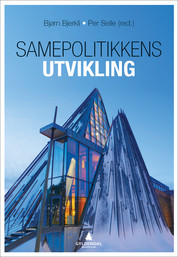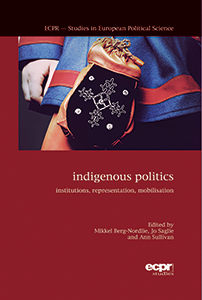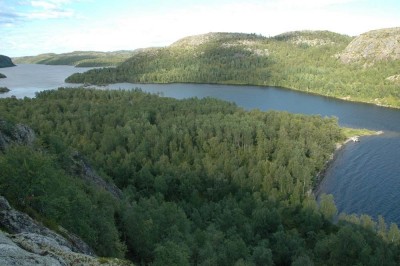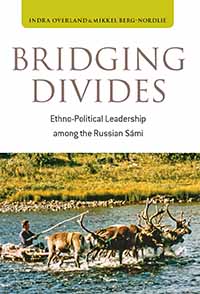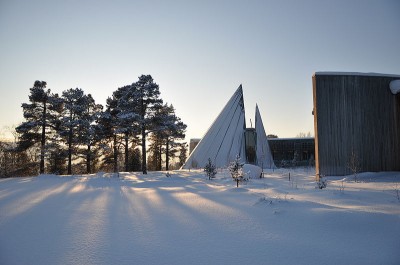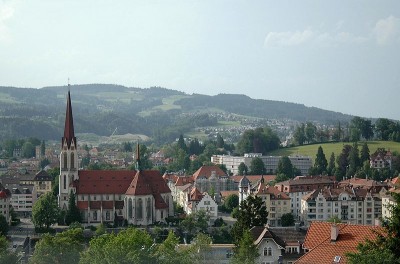After a group of Russian Sámi held a demonstration, authorities accused them of being agents for Norway. How did we end up here? What does this mean for the Sámi movement – and for Norway?
By Mikkel Berg-Nordlie
It happened on August 9, the UN International Indigenous Peoples’ Day. Outside the City Hall of Murmansk in Northwest Russia the day was used to demonstrate by a group of indigenous activists associated with the campaign for a Russian Sámi Parliament. The activists had been denied hoisting the Sámi flag outside the building, and wanted a word with the authorities over the matter.
Indigenous Activists – Western Spies?
Local media took an interest. In the end, a spokesman of the provincial authorities emerged with a written message to the journalists. The message warned that the activists did not represent the Russian Sámi. Rather, they represented Norwegian interests. Indeed, it said that they were even funded by the Norwegian Sámi Parliament.
The Odd One Out
Let’s back up. Most likely you, the reader, do not know what a “Sámi Parliament” is. The Sámi Parliaments are elected advisory and (to a limited extent) participatory political organs of the Sámi – North Europe’s indigenous nation. They are elected by self-registered Sámi in Finland, Norway and Sweden. Russia is the only one of the four states that originally split the Sámi homeland (Sápmi) between them, which does not have such an institution.
A Self-Made Parliament?
Russian Sámi activists have been demanding such an institution in Russia for long – with no success. In 2010 some of them decided to simply hold self-organized elections. A province-wide gathering of Sámi individuals cast their votes and elected a 9-person council, declaring that they had now formed a Sámi Parliament and demanding that the provincial authorities should recognize them as such.
One People – Two Councils
The provincial authorities were less than thrilled. Already in 2008 they had responded to the mounting campaign by forming their own indigenous council. Members of the Murmansk Indigenous Council under the Governor are selected by the Governor, out from suggestions by the obshchiny. The obshchiny are non-profit indigenous NGOs aimed at revitalizing traditional Sámi cultural practices, f. ex. family-based reindeer herding.
For the last four years, the Murmansk Indigenous Council has been meeting with representatives of the authorities to give advice on indigenous issues.
Sam Sobbar: A Success In The West And South – But Not Locally
The self-declared Sámi Parliament, Kuellnegk Nyoark Sam’ Sobbar, has until now been largely ignored by regional authorities. They have, however, succeeded in being treated as a legitimate institution by RAIPON – the Russian network of indigenous NGOs – and in the West.
Representatives of the Sam’ Sobbar has participated in several pan-Sámi fora, Western Sámi Parliaments have given moral support to the initiative, and its leader Valentina Sovkina is recognized by the Barents Region’s Working Group of Indigenous Peoples as the representative of the Russian Sámi.
Why Western Support?
Why has the Sam’ Sobbar been accepted so eagerly into the Western fold? The Murmansk authorities’ media spokesman implied that this was rooted in Western interests. This accusation assumes a degree of state control over pan-Sámi politics which, frankly, does not appear to exist. Rather, there are several other reasons.
* The Sam’ Sobbar activists were already at the outset better connected to the pan-Sámi political network, than individuals in the Murmansk Indigenous Council. (1)
* The Murmansk Indigenous Council has not made any effort to connect with pan-Sámi politics (1).
*Western Sámi-oriented media have scarcely reported on the existence of the Murmansk Indigenous Council. The Sam’ Sobbar, conversely, has often been referred to as “the Russian Sámi Parliament” without comment. (2)
* Most fundamentally, though: the Sam’ Sobbar speaks a political language that falls on fertile soil in the Nordic countries (2, 1).
Fitting Neatly Into Western Sámi Discourse
From the perspective of Nordic Sámi politicians and activists, it seems obvious that one should support a movement for a popularly elected Sámi organ in Russia. The introduction of such structures were considered a symbolic and practical breakthrough in the Nordic countries. Why would they not wish for their neighbors what they, themselves, enjoy? Indeed, the very idea of a border-transcending Sámi nation has as a logical consequence that if the Nordic Sámi have Sámi Parliaments – so should the Russians. One for all, and all for one.
Democracy To The Russian Sámi?
Furthermore, the Sam’ Sobbar campaign fits in with certain Western expectations about Russia. In the West, people are used to thinking about Russia as an authoritarian superpower needing to import democratic institutions. The Sam’ Sobbar activists are easily perceived as a grassroots movement for democratization, needing Western support.
For Western observers, the structure of the Murmansk Indigenous Council seems to confirm this: it is difficult for people in the Nordic countries to accept as legitimate, a council seemingly consisting of hand-picked representatives – at that, only from one sector of Sámi civil society, the obshchiny.
The Securitization of Sápmi
On the Russian side of the border, it is often heard in this debate that ethnic parliaments are undemocratic – undermining majority rule by giving too many rights to ethnic minorities. Such arguments are also heard in the Norwegian debate, but not from the authorities (3).
Now, as a fact: there are officially sanctioned councils of elected indigenous representatives elsewhere in Russia (1). But Murmansk is not just anywhere in Russia: part of the border that divides Western Sápmi from Russian Sápmi is also a direct border between Russia and NATO.
Since Soviet times this has been a highly securitized area, where the local border-transcending people has historically been treated with a certain skepticism – at worst outright suppression. When viewed through the security lens, Western institutions’ support for a Sámi Parliament in Russia serves to make the local authorities more skeptical to the idea.
What Kind of Sámi Politics?
Nonetheless, provincial authorities’ approach to Sámi politics today, is a far cry from the suppression of old. The politically themed Indigenous Peoples’ Day celebration in Murmansk was indeed met with accusations. However: simultaneously there was an officially sanctioned – cultural – celebration of the Indigenous Peoples’ Day, in the inland city of Apatity. Governor Marina Kovtun has also stated that the authorities shall look for opportunities to fund Sámi-language classes for school children.
The authorities may hence be convinced to support measures for the survival of Sámi language and culture. Demands for rights to land and self-determination -issues fronted by the Sam’ Sobbar – are less warmly received.
Norway Accused By Proxy
On the Indigenous Peoples’ Day, the authorities went from ignoring to confronting the Sam’ Sobbar. Notably, though, this was not a formal accusation of espionage – just a statement to the media. It has so far not been followed up. How far up in the hierarchy were the contents of this message clarified? Was this just the brainchild of a local media spokesman, or should it be interpreted as a warning from «higher up»?
If the authorities follow up on the accusation, consequences could be dire for the local activists concerned. Also, it would lead to an interesting situation for Norwegian-Russian relations. Norway would then have been accused of running an ethnically based opposition movement inside Russia. That would fit poorly with Norwegian ambitions to remain on friendly terms with their eastern neighbor.
1. Berg-Nordlie, M. (2011): “Striving to unite.” (Arctic Review on Law and Politics )
2. Berg-Nordlie, M. (2011): “Need and Misery in the Eastern Periphery.” (Acta Borealia).
3. Berg-Nordlie, M. & A. Schou (2011): “Who are indigenous – and how does it matter?” (Ethnopolitics Papers )
Also check out the soon-to-be-published article “The Iron Curtain through Sápmi.” (Humanistica Oerebroensia), and (with Indra Overland) the fortcoming book “Bridging Divides” (Berghahn Books ).
Mikkel Berg-Nordlie is writing his PhD on Sámi internationalization (pan-Sámism) and Russian Sámi politics, at the University of Tromsø . This blog post is loosely based on an article published in the North Norwegian daily Nordlys on August 21, 2012.
